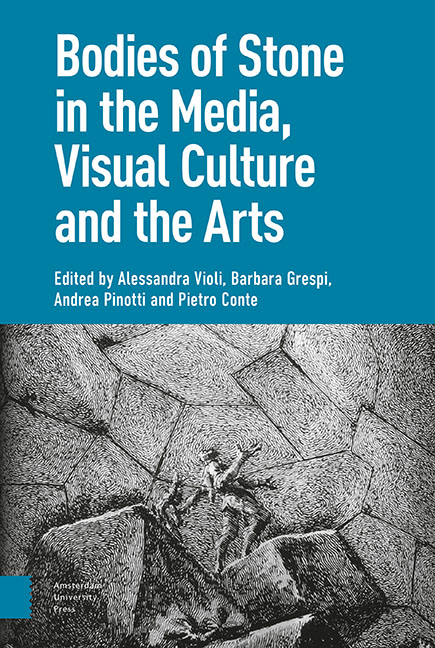Book contents
- Frontmatter
- Contents
- Introduction: Learning from Stone
- I Statue: The Imaginary of Uncertain Petrification
- 1 Theatre and Memory: The Body-as-Statue in Early Modern Culture
- 2 Translated Bodies: A ‘Cartographic’ Approach
- 3 Pantomime in Stone: Performance of the Pose and Animal Camouflage
- 4 Animated Statues and Petrified Bodies: A Journey Inside Fantasy Cinema
- 5 The Ephemeral Cathedral: Bodies of Stone and Configurations of Film
- II Matter: Size, Hardness, Duration
- 1 Bodies That Matter: Miniaturisation and the Origin(s) of ‘Art’
- 2 Brancusi’s ‘Sculpture for the Blind’
- 3 Cinema, Phenomenology and Hyperrealism
- 4 Ephemeral Bodies: The ‘Candles’ of Urs Fischer
- 5 The Celluloid and the Death Mask: Bazin’s and Eisenstein’s Image Anthropology
- III Corpse: Fossils, Auto-Icons, Revenants
- 1 Funeral Eulogy: Post-Mortem Figures and Redeemed Bodies, in Images
- 2 On Jack Torrance As a Fossil Form
- 3 Technical Images and the Transformation of Matter in Eighteenth-Century Tuscany
- 4 Glass, Mixed Media, Stone: The Bodily Stuffs of Suspended Animation
- 5 Bodies’ Strange Stories: Les Revenants and The Leftovers
- IV Monument: Embodying and Grafting
- 1 The Impassibly Fleshly, the Statue of the Impossible
- 2 Frozen into Allegory: Cleopatra’s Cultural Survival
- 3 The Orphan Image
- 4 The Well-Tempered Memorial: Abstraction, Anthropomorphism, Embodiment
- 5 Monuments of the Heart: Living Tombs and Organic Memories in Contemporary Culture
- Index
4 - Animated Statues and Petrified Bodies: A Journey Inside Fantasy Cinema
Published online by Cambridge University Press: 20 November 2020
- Frontmatter
- Contents
- Introduction: Learning from Stone
- I Statue: The Imaginary of Uncertain Petrification
- 1 Theatre and Memory: The Body-as-Statue in Early Modern Culture
- 2 Translated Bodies: A ‘Cartographic’ Approach
- 3 Pantomime in Stone: Performance of the Pose and Animal Camouflage
- 4 Animated Statues and Petrified Bodies: A Journey Inside Fantasy Cinema
- 5 The Ephemeral Cathedral: Bodies of Stone and Configurations of Film
- II Matter: Size, Hardness, Duration
- 1 Bodies That Matter: Miniaturisation and the Origin(s) of ‘Art’
- 2 Brancusi’s ‘Sculpture for the Blind’
- 3 Cinema, Phenomenology and Hyperrealism
- 4 Ephemeral Bodies: The ‘Candles’ of Urs Fischer
- 5 The Celluloid and the Death Mask: Bazin’s and Eisenstein’s Image Anthropology
- III Corpse: Fossils, Auto-Icons, Revenants
- 1 Funeral Eulogy: Post-Mortem Figures and Redeemed Bodies, in Images
- 2 On Jack Torrance As a Fossil Form
- 3 Technical Images and the Transformation of Matter in Eighteenth-Century Tuscany
- 4 Glass, Mixed Media, Stone: The Bodily Stuffs of Suspended Animation
- 5 Bodies’ Strange Stories: Les Revenants and The Leftovers
- IV Monument: Embodying and Grafting
- 1 The Impassibly Fleshly, the Statue of the Impossible
- 2 Frozen into Allegory: Cleopatra’s Cultural Survival
- 3 The Orphan Image
- 4 The Well-Tempered Memorial: Abstraction, Anthropomorphism, Embodiment
- 5 Monuments of the Heart: Living Tombs and Organic Memories in Contemporary Culture
- Index
Summary
Abstract
The essay aims to show the aesthetic and philosophical implications of the polarity between the animation of stone and the petrification of the body through a journey inside fantasy cinema and horror movies. The examples offered by horror movies like The Haunting(Robert Wise), Un Angelo per Satana(Camillo Mastrocinque) and La Venere d’Ille(Mario and Lamberto Bava) re-enact the mythical imagery of the animated statue as the intertwining of simulacrum and living body. Unlike these gothic models, two postmodern masterpieces, After Hours(Martin Scorsese) and Dead Ringers(David Cronenberg), evoke at the same time the ghost of contemporary sculpture and the cinema device as simulacra-producing machine.
Keywords: Fantasy cinema; animation; horror movie; simulacrum; virtual body
Since its very origins, cinema has had a strong attraction to the imagery of statues, that is to say petrified bodies, providing a new interpretation in particular of the polarity between the animation of stone and the petrification of the body. This polarity has been a leading thread—at times submerged, at times explicit—in the Western imagination since the history of archaic sculpture up to the contemporary debate on simulacra, from Ovid ̕ s tale of Pygmalion and Galatea to the myth of Medusa. The inventory I present here—consisting of three examples directly stemming from genre movies in addition to two more examples somehow more heterogeneous and problematic—does not aspire to be exhaustive nor exemplary. It rather acts as a distinctively interesting incentive inasmuch as it triggers unprecedented conceptual and media-related flashes of insight through the comparison of the mythical imagery of statues, its literary version codified according to somewhat institutionalised fantasy (i.e. fantasy literature), and ultimately the cinematic interpretation of this conceptual hub. The reference to archaic and mythical imagery within movies harks back to a pre-cinematographic background as it enters into dialogue with cinema's specific means. Conversely, it is equally possible to detect cinematographic anticipations in the history of visual devices, in mythical tales, as well as in the history of aesthetics and theory of art.
- Type
- Chapter
- Information
- Bodies of Stone in the Media, Visual Culture and the Arts , pp. 89 - 104Publisher: Amsterdam University PressPrint publication year: 2020



